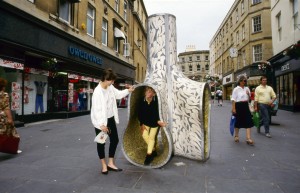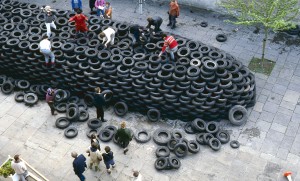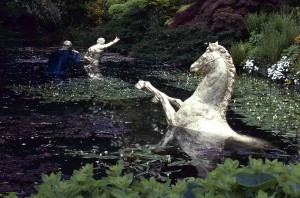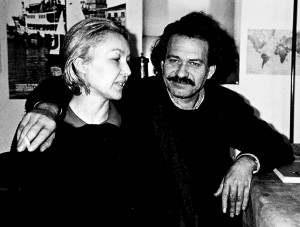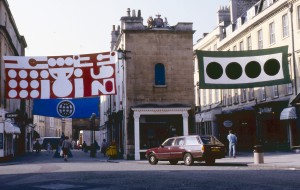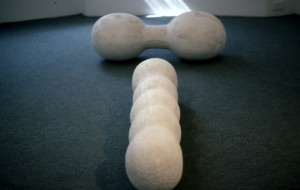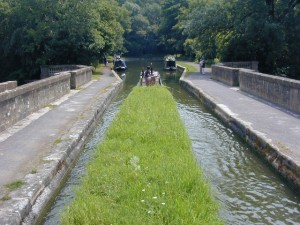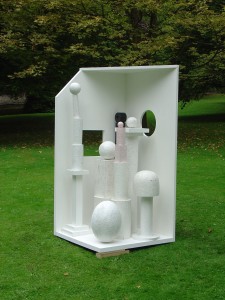Sculpture in the City was the final event of its kind. After a decade or more of sculpture exhibitions in the city of Bath as part of Bath International Festival, Sculpture in the City marked the end of a glorious period for contemporary sculpture placed among the Georgian squares, terraces and parks of Bath. Throughout the seventies and eighties there were exhibitions of Sculpture in the Open Air, not only in Bath, but all over Britain. Described by some as Helicopter Art – these exhibitions involved strange objects appearing overnight, as if dropped from above, surprise arrivals into places of common ownership and without consultation, placed there for edification or entertainment. There was a succession of mixed shows in gardens, parks and city spaces, in art galleries, museums and inside and outside cathedrals. Several of these grand exhibitions took place on more than one site and occasionally there were simultaneous events in several cities. Some of these sponsored by Peter Stuyvesant, it took a while before cigarette sponsorship of the arts was proscribed. It was the technical advance of polyester resin with fibreglass matting that enabled sculptors to make larger and lighter work, easier to transport and, in the short term at least, weather resistant. As well, there was sculpture made from hard-core traditional materials; stone and wood, but rarely bronze. This coincidence between a movement towards sculpture in public places and my own career and experience, instilled in me a preference for my sculpture being freely available. I thought this freedom a better choice than my work being out of sight, in a small room (in a gallery) that was little more than a shop. This was the beginning of my not-for-profit attitude. I would rather have my sculpture ‘at work’ than hidden in storage. I ‘grew up’ looking at sculpture exhibitions held in Battersea and Holland Park and on the greens surrounding Canterbury and Winchester cathedrals. I followed Sculpture Trails in Grizedale Forest and across the Forest of Dean, and then The Yorkshire Sculpture Park took off. During this period Bath was, as far as the visual arts were concerned, and particularly sculpture, the most adventurous and exciting city in this country and, in this respect, stood comparison with Festival cities throughout Europe. I appeared from time to time wearing various caps – as a participating sculptor, as a consultant, as an organiser and as curator.
Once more I am presenting my readers or listeners with a list, one that has been assembled from discarded fragments, the residue of an archive that had been dispersed on the woeful demise of Artsite – an event that heralded the cessation of major visual art events in Bath. Nevertheless, it is an impressive list. It is a catalogue of events that exemplifies the hard work, commitment, generosity and goodwill which made Bath a special place for contemporary sculpture. In spite of their success and popularity, these exhibitions did not generate income. In fact, the exact opposite, installing sculpture in the open air is expensive, incurring serious transport, workforce and insurance costs.
June 1985 saw the arrival of Sean F. Kelly as Director of Art in Bath, to take over the Festival Gallery. This was a modest enterprise, situated downstairs in Linley House, half-hidden in Pierrepont Street. Kelly was a one-man band who made things happen: the first of these was a name change, from the ‘Festival Gallery’ to ‘Artsite’.
During 1986 I was organising the Sculpture in the City exhibition, a show of more than twenty sculptors exhibiting in public places in Bath. Sculpture in the City was intended to herald the move of Bath Academy of Art from Corsham to Sion Hill as part of Bath College of Higher Education, as it then was then. An event that was the beginning of an annual collaboration between the Fine Art Course at BCHE and Bath International Festival. These were joint ventures which celebrated the work of internationally renowned artists. Jannis Kounellis, from Italy, who exhibited at Artsite and in Walcot Chapel; an installation made possible by the assistance of four sculpture students from BCHE. The next year was the turn of the American, Matt Mullican, whose bronzes were cast in the foundry at Sion Hill. From Germany, Rebecca Horn showed her work in the steaming mineral waters of the Cross Bath and at Artsite, However it was a Stone carving symposium/competition in Victoria Park, that kick-started sculpture throughout the city of Bath in 1986. The winner was poet/sculptor Kier Smith.
Sculpture in the City: Bath 1986 was my own initiative, enthusiastically supported by the new Dean, Colin Painter, and financially supported by the School of Art and Design, the Arts Council and the Henry Moore Foundation. Richard Cork and Peter Fuller each wrote companion texts for the catalogue. They were literally on the same page, but not of the same mind! Participating sculptors in the exhibition were limited to current students and permanent and regular staff and current/recent visiting lecturers.
Sculpture that was sited on shopping thoroughfares included work by Andrew Sabin, Denise de Cordova and Simon Read. A sculpture by Charles Hewlings occupied the precinct of Bath Abbey; there was David Mach’s assemblage of rubber tyres in Alfred Street alongside the Assembly Rooms, and in Parade Gardens there was sculpture by Richard Deacon and Laura Ford and Nicholas Pope. Several works were made for specific places and some made on site during a three-week period, Mark Dunhill and Dave King in Royal Victoria Park and Lorraine Frost and Richard Lawrence in Queen Square. There were two exhibitions; at Artsite, there was figurative sculpture, including work by Colin Crumplin, Peter Green and Kenneth Hughes, Glynn Williams and Vincent Woropay.
Remarkably, during the same summer weeks in 1986, Bath saw the Anne et Patrick Poirier exhibition, Lost Archetypes. Kelly had planned this exhibition of sculpture in the gallery and throughout the city. It was their first in Great Britain, the major visual art presentation on the occasion of Bath International Festival’s celebration of French culture.
Consequently in 1986 Bath was Sculpture City!
1987Jannis Kounellis: The Bath International Festival celebrated Italian art and culture. The City of Bath provided the perfect setting for such a celebration, with its historic association with Roman civilisation. Kounellis gave a lecture to students at Sion Hill, BCHE, (Michelle Coudray was his interpreter)
1988 Mullican Matt Mullican was invited to contribute to the American theme for the 39th Bath International Festival. Mullican made three distinct yet interlinked presentations. The first was for the Artsite gallery, a series of square rubbings on paper, which form a library of images. Many of these were used again in the second work; two large-scale installations in the heart of the city – one comprising four banners hung above street level and four bronze plaques set into the pavement in Old Bond Street/Burton Street. The third work was a large relief comprising numerous slabs of Bath stone and installed at Beaufort Square.
Also in 1988. Traces. Works from South India. Stone works by Stephen Cox. placed in the Georgian Circus. And again in 1988 – a series of exhibitions at the Victoria Art Gallery by the artists teaching on the Fine Art Course at Sion Hill – beginning with Peter Kinley and ending with African.
In 1989 Rebecca Horn played her part in the Bath International Festival celebrating the art and culture of West Germany. Missing Full Moon. For this first exhibition of Horn in Britain, Artsite produced a most comprehensive catalogue, with a text by Lynne Cooke.
1989. Ensembles Michael Pennie – an exhibition organised by Sean Kelly but expedited by Brenda McParland: (Kelly had gone to live and work in New York). A show immediately following Missing Full Moon but utilising the interior spaces with two groups of wood works: standing sculptures in the first room and floor works in the second. I have a sense that my sculptures are most ‘active’ when they are on parade, although some more than others. Often the predicted successes disappoint and other, more unassuming sculptures, surprise. At the beginning of a show, sculptures may be prioritised (by the artist) as to their importance and significance, but at the end of the exhibition, that inventory is usually quite different. Spike was carved for a Canterbury park, for Sculpture on the Map (an exhibition organised by Tom Pemberton). It was too tall for Artsite, where I wanted it to be the centre of attention in the ‘vertical’ room. Carefully we cut off the top – that is, Geoff Hawkins did, as he has a better saw hand than I do. Spike rose to exactly ceiling height and the cut-off peak provided a stabilising part that fixed the work to the floor. This was quite an innovation for me, a shift in thinking towards the site specific.
1990. Txomin Badiola. This was a Bath International Festival Exhibition, curated by Brenda McParland, who was then Director of Art at Artsite. The exhibition celebrated the Art, Culture and Music of Spain both at Artsite and also throughout the City of Bath.
1991. Present Continuous at Bath Old Reference Library in Queen Square; curated Caryn Faure Walker, Director of Artsite Trust.
Henry Moore International Fellow; Perejaume from Catalonia, exhibited at Bath Old Reference Library – New Artists in 1993.
1994. Well-Spring: Messages and Revelations by Contemporary Artists to Animate the Ancient City of Bath. An exhibition curated by Angela Kingston and Antonia Payne – in places throughout the city including the Podium Shopping Centre and George Bayntun Bookbinders and especially at the Empire Hotel. Exhibiting artists included Susan Derges, Sharon Kivland, David Nash, Kathy Prendergast and Cai Guo Quiang.
Henry Moore International Fellow In 1995 Anne Messner from New York exhibited at Walcot Chapel, an installation called heart and ear. Also during 1995 there was The Green Room; views on an 18th century Pleasure Ground in Sydney Gardens and several other sites; conceived and directed by Caryn Faure Walker.
1996. Igor Mitoraj, the Polish sculptor exhibited in the Hotbath Gallery and sites in the city; curated by Jane Connarty. The Hotbath Gallery, so adeptly managed by Cheryl Cooper, soon followed Artsite into oblivion. This completed the expiration of the two most important contemporary art galleries in Bath (during the period dealt with in this chapter), both supported by public funding and each one with the mission to show new works, rather than to sell them.
1997. At Festival time the Flemish artist and playwright Jan Fabre installed Seven Rooms in different places around the city. This major presentation was shared between Bath, Bristol and Cardiff.
My introduction to Tania Kovats was through our mutual friend, Rachel Evans-Milne, a Royal College student with Kovats, and a colleague of mine. We first met one Sunday for lunch, somewhere in Wiltshire, a gathering of sculptors, there to walk along Kovat’s Contour, a very green crop of oats – commissioned for Secret Gardens as part of the 1999 Salisbury Festival.
In the monograph Tania Kovats, there is an introduction to MEADOW where Kovats writes, “ MEADOW owes a great debt to the sculptor Michael Pennie who was the engine of the work and walked along with me the entire length of its journey from conception to its end; I am also indebted to Peter Boyce the captain of Betelgeuse; and the lovely Irene. Thank you to Bath Spa University, to Professor Ron George for his support and the many students and staff on the Fine Art and Graphic Design courses who were involved and helped bring MEADOW to life and keep it afloat. Thank you too, for the generosity of Graham Webb and the Horticultural students at Lackham College who loaned me their meadow for the journey”.
Bringing the canal barge down from Newbury to Bath in the pouring rain – my first day on board and my first sight of the waterway I slipped and fell, spraining a wrist. This was the first of a series of misadventures that convinced me that canals and I were not compatible. Indeed I fell out of the barge and then into the barge and only narrowly avoided a full dipping in the canal.
However I did a good job as a car driver, taking on the extraordinary mileage required to ferry personnel between cars and barge. Each morning going in two cars, one driver in each, to where the barge was to be moored for the night. Parking one car, I drove my car with driver number two, back to the start point, where the barge was waiting to undertake a relatively short distance on the canal to the day’s end point. Then drive back in the car parked there to the car left behind at the beginning!
We chose Sydney Gardens for a grand send off, where MEADOW would depart Bath for London, negotiating canals and inland waterways on a journey that would take three weeks. A replica flowering meadow stayed behind, grown and nurtured by students at Sion Hill.
My last sculpture project to date, in Bath, was Sculpture Within: seven woodcarvings, sheltered. A sculpture placed at Sion Hill during the summer of 2007.
Not long ago travelling on a number 36 bus in London I caught sight of three sculptures by William Turnbull, not the best way to see 3×1 1966, Large Horse 1990 and Large Blue Venus 1990 – a mixed bag of works sited on the Park Lane Central Reservation and part of Westminster City Council’s City of Sculpture Festival and a welcome acknowledgement that contemporary sculpture is an enrichment to city life.
